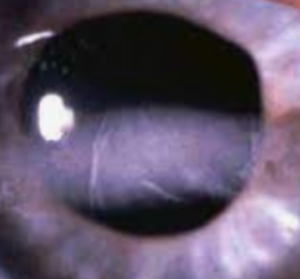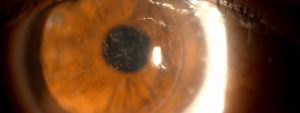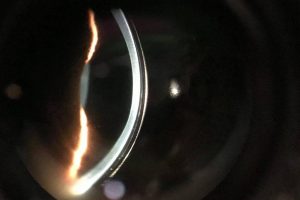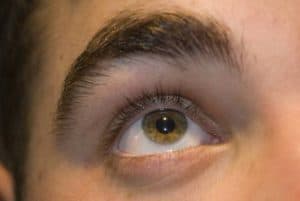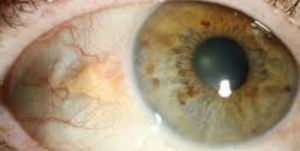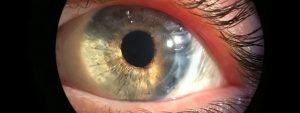Approximately 4 percent of adults have the painful eye condition, Fuchs dystrophy.
What is Fuch’s dystrophy?
Fuchs’ dystrophy is a corneal disease, occurring when the endothelium, the back layer of the cornea, gradually dies.
To maintain a clear cornea, the endothelial cells must pump fluid out of the cornea into the anterior chamber. When these cells die, fluid collects in the cornea, causing it to swell. Vision becomes hazy or cloudy.
There are two stages to Fuchs’ dystrophy. Morning vision is frequently cloudy in the early stages (stage 1), but clears up as the day progresses. In the later stages (stage 2), vision stays blurry throughout the day.
Fuchs’ dystrophy can affect people in their 30s and 40s, but they are often unaware that they have the condition as vision difficulties may not manifest itself until age 50 or later.
Fuchs’ dystrophy symptoms
You may notice few, if any, signs in the early stages of Fuchs’ dystrophy. There are two distinct stages of Fuch’s Dystrophy.
Stage 1:
When you wake up your vision may be blurry due to moisture accumulation in the eyes while you sleep, but the vision may improve throughout the day as the moisture dries up.
Stage 2:
If your blurry or hazy vision will not improve as the day progresses, the condition has progressed to stage 2, when the sleep-related fluid buildup doesn’t dry up sufficiently during the day.
In addition, during stage 2, small blisters in the cornea may occur.
Blisters of fluid grow in size and eventually break open, producing intense pain in the eyes.
Other signs and symptoms include:
- Gritty or sandy feeling in your eyes
- Sensitivity to bright light
- Humidity in the air exacerbates eye problems
- Very hazy or blurry vision from scarring at the center of the cornea
If you suspect you may have Fuchs dystrophy, contact an eye doctor near you.
SEE RELATED: Corneal Diseases
What are the causes of Fuchs dystrophy?
Endothelial cells, which line the inside of the cornea, help to maintain a healthy balance of fluid within the cornea and keep it from bulging.
The endothelial cells of Fuchs’ dystrophy, on the other hand, eventually die or fail to function properly, leading to fluid buildup (edema) within the cornea.
Corneal thickening and fluid-filled blisters result in blurry vision.
Fuchs’ dystrophy is frequently inherited. The disease has a complex genetic basis, and family members may be affected to varying degrees or not at all.
What are the risk factors of Fuch’s dystrophy?
Fuchs’ dystrophy is caused by a combination of risk factors that include:
- Age – Although there is a rare form of Fuchs’ dystrophy that develops in childhood, the disease usually begins in the 30s or 40s, with symptoms appearing later.
- Genetics – A family history of Fuchs’ dystrophy increases your risk.
- Gender – Women are more likely than men to develop Fuchs’ dystrophy.
How is Fuchs dystrophy treated?
Fuchs’ dystrophy symptoms may be relieved by nonsurgical treatments and self-care techniques. If your case is serious, your doctor may recommend surgery.
- Contact lenses
- Eye medication – Eye drops or ointments containing saline can help lower the amount of moisture in your cornea.
- Soft contact lenses – Can be used as a covering ‘bandage’ to relieve pain.
People with advanced Fuchs’ dystrophy who have surgery often attain significantly better eyesight and may remain symptom-free for years. Surgical options include the following:
- Transplanting the inner layer of the cornea (DMEK) – This surgery, known as Descemet membrane endothelial keratoplasty (DMEK), involves replacing the back layer of the cornea with healthy endothelial cells from a donor. However, DMEK may not be a possibility if you have another eye condition or have had previous eye surgery.
- Corneal transplant (DSEK)- A partial-thickness corneal transplant, also known as Descemet-stripping endothelial keratoplasty (DSEK), may be recommended by your doctor.
- Penetrating keratoplasty (PK) is a full-thickness corneal transplant that is only recommended in rare cases.
LEARN MORE: Guide to Corneal Conditions
Contact an eye doctor near you, to learn more about Fuchs dystrophy and determine which treatment option is best for you.
Fuchs’ dystrophy is a corneal disease, occurring when the endothelium, the back layer of the cornea, gradually dies.
There are successful options that can treat this corneal condition.


